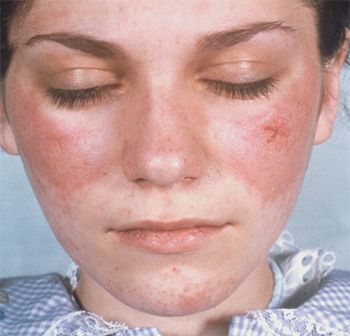Lupus and Mottled Skin
What is mottled skin?

Livedo reticularis is another word for mottled skin. It can appear as a reddish-blue, net-like pattern on paler skin. On darker skin tones, it can appear as reddish-purple, darker patterns.
Mottled skin does not always point to a health condition. However, it can signify underlying conditions, including lupus. Mottled skin can appear on a baby, or livedo reticularis may show up after a shower.
Lupus
Lupus is an autoimmune disease that can cause mottling of the skin. Livedo reticularis is a complex symptom of lupus. As a systemic disease, lupus causes widespread alterations in multiple body systems.
Systemic lupus damages your blood vessels and tissues, decreasing blood flow to your skin. This causes multiple skin disorders. Some include Raynaud’s phenomenon, rheumatoid nodules, ulcers, and lesions.
What are the main types of livedo reticularis?
The three main types are:
- Physiologic: This temporary, harmless condition — also called cutis marmorata — is due to cold exposure. It goes away when your skin warms up. Mottled skin when cold typically affects infants, children and young women and people assigned female at birth (AFAB) with lighter skin.
- Primary livedo reticularis: This type of mottled skin occurs when blood vessels just below your skin’s surface suddenly constrict for unknown reasons. It’s temporary and unrelated to temperature changes. Primary livedo reticularis is diagnosed when underlying conditions have been ruled out.
- Secondary livedo reticularis: Skin mottling occurs as a complication of underlying medical conditions. These include vascular disease, neurological disorders, certain cancers and infections. Secondary livedo reticularis is persistent, meaning that it doesn’t go away until the underlying condition is diagnosed and treated.
What are possible livedo reticularis causes?
The primary cause is decreased blood flow to your skin. When this occurs, oxygen-poor blood from tiny blood vessels pools under your skin. Mottled skin can have many other causes, including:
Autoimmune and connective tissue disorders
Autoimmune and connective tissue disorders that can lead to mottled skin include:
How is mottled skin diagnosed?
Healthcare providers diagnose livedo reticularis by looking at your skin. They may review your health history and any chronic illnesses you’ve had. You may also need a skin biopsy or lab studies, such as urinalysis or blood tests.
WHEN TO CALL THE DOCTOR
Contact your healthcare provider if you notice a dark lace-like pattern on your skin. Since livedo reticularis can be a sign of many medical issues, a timely assessment is essential. This information helps your provider determine the cause so that you can receive treatments, if necessary.
Reference
Mottled Skin (Livedo Reticularis): Looks Like, Causes, Treatment (clevelandclinic.org)
